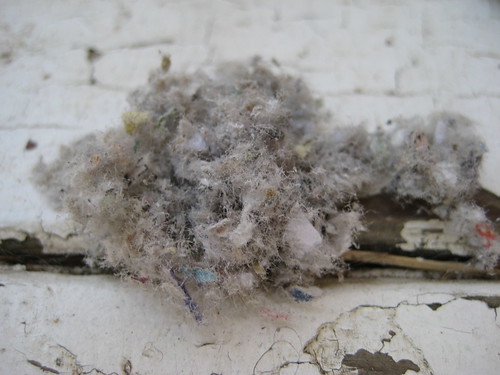
Yesterday I had to work from home, so I decided to take advantage of that fact and have the attic insulated. This is something we've been planning for a while, and I wanted to get it done before the weather became too hot. So, I called up Everguard Home Insulation and made an appointment to have cellulose insulation blown into the attic.
Everguard was great. They showed up as scheduled, after calling to let me know they were on the way, and communicated clearly about what they were planning to do. They worked quickly and cleanly and got our 950 ft2 attic filled in about 45 minutes. Impressive.
The fluff blob above is a small chunk of the cellulose insulation that escaped from a roof vent. As you can see, it's basically fluffy, ground-up newspaper and cardboard fibers. To make it fire retardant, the cellulose is treated with boric acid. Unlike fiberglass, cellulose is recycled, environmentally friendly and non-toxic. So, it's perfect for green-living homeowners, like us.
And for frugal homeowners, the Southern California Gas Company offers a rebate of 15 cents per ft2. So we'll actually get a check for $142.50 after we submit our paperwork. Plus, there's a 2009 federal energy efficiency tax credit for 30% of the cost. So, we'll get even more money back when we file our tax returns. With all those incentives, I can't imagine not insulating the attic.
The new insulation, combined with some old, compressed and ratty fiberglass that was already up there, brings our attic insulation level up to R-38. This should hopefully make a big difference in how hot it gets inside the house this summer, especially when combined with new wall insulation, new ceiling fans and our solar attic fan.
I've said it before and I'll say it again, Who needs air conditioning! (Check back with me in July for the verdict on that one.)


This is great! I didn't even know cellulose insulation existed until now. Seems like a great way to recycle cardboard and paper.
Only thing I'd be concerned about is fire, but you say the boric acid makes it fire resistant. I wonder how that works.
Which solar attic fan did you choose and how did you decide?
It just so happens that I'm the owner of Everguard Insulation and a customer told me about this blog. Small world, lol.
Cellulose insulation is entirely Non-Flammable (they don't rate materials as 'fire-proof'). You can put a match to the cellulose or even a torch and it won't burn. In fact, cellulose makes the home 57% more flame-spread resistant. It meets all the ASTM, UL-label and CPSC requirements for non-flammability! Fiberglass merely melts and after a few years of accumlating dust becomes flammable.
Cellulose has a higher R-value per inch then fiberglass and it's non-toxic, non-corrosive and even hypo-allergenic. It doesn't itch, it has a life-time guarantee to never settle or pack and it's resistant to insects, rodents and even mold. In all, it's more effective, longer-lasting and safer then fiberglass.....and it doesn't cost more. Also, when we blow it in, it covers over everything as a solid blanket which makes it 38% more effective then the rolled fiberglass product.
Open the windows at night and let the house cool-down...close things in the late morning; watch and see how cool the house will remain. I have a few customers who claim to only need the A/C when we're experiencing extreme heat-waves. The insulation also works in the winter to hold the heat in.
Almost 50% of the cost of insulating is subsidized by rebates and tax-credits and the remaining cost is often paid for with savings in less then a year.
Not having a well-insulated home is as silly as driving a car with a leaky gas tank or buying a refrigerator with no door. Save money, help the environment: Win-Win! Sorry if this seems like spam, I'm just into what I do and enjoy answering questions. -Steve
I'm doing this myself and have read tons of material and watched installation videos to no end.
What I can't figure out is if a vapor barrier is actually needed in southern California.
If I have to staple plastic it will make it more tedious since the attic crawl space is less than three feet and I'm 6' 275lbs.
Blowing it in is no problem since I can clamp a few lights and belly up on a few plywood boards that can be alternated to give me a back out.
I can't find a shred of info regarding this.
Any light on the subject would be helpful!
I'm not an expert, but I don't think you'd need an moisture barrier in Southern California, considering how dry the air is here. We certainly weren't offered that option when I called around about cellulose, and, one imagines, if it was something people needed (or wanted) then someone would have tried to sell it to me. You might want to just call an insulation company and ask if they offer moisture barriers and why. Then you can get their expert opinion, even if you don't necessarily hire them.
I'm an Insulation Sales Specialist in SoCal. Only 2 Climate Zones in California Require Vapor Barriers; CZ 14 & 16. Basically they're located in the high desert (Palmdale/Lancaster), or the Mountains. If you're doing blown-in, save yourself the hassle and hire a professional like Steve at Everguard. The Professionals are used to climbing around in attics, and they're less likely to fall through the ceiling or inadvertantly screwing up wires and ducts. Finally, they'll probably be cheaper than if you do it yourself. CHEERS!